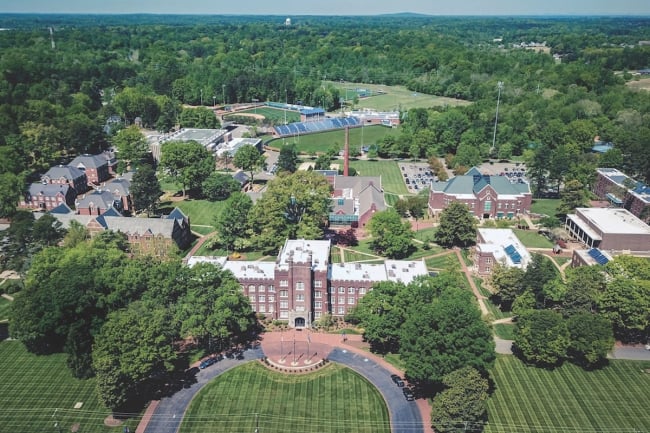You have /5 articles left.
Sign up for a free account or log in.

Catawba College, pictured above, is planning to build a new student center in a building that once held a coal-burning smokestack using funds from a large gift.
Contributed photo
A small liberal arts college in North Carolina just received a donation of $200 million—for the second time in three years.
Back in 2021, Catawba College received a historic $200 million donation from an anonymous donor, more than tripling the college’s endowment. A third of the gift was set aside to support the university’s programs in environmental education, while the remaining two-thirds went toward strategic initiatives, student scholarships, faculty development, student success and more.
Now history is repeating itself. The college announced another anonymous gift of the same amount on Monday; again, a third will be put toward environmental education programs as well as larger sustainability efforts on campus. This time, the remainder will be unrestricted.
Between the two donations—and an additional $42 million anonymous gift in 2022—the college’s endowment grew from about $100 million in 2020 to $580 million today.
The 2021 gift was used to improve wages and benefits for employees, update campus facilities and renovate Catawba’s Center for the Environment, a venue for environmental learning that abuts the campus’s ecological preserve, according to college president David P. Nelson.
This time, the $200 million will be used to achieve goals laid out in the university’s new strategic plan.
“We just finished the first year of priorities. We’re beginning the second year, so we have a clear direction on what we want to do and where we want to go,” said Nelson. “These funds will help us to get there, and in some instances, will help us to get farther, sooner, than we might have expected.”
The approximately $66.6 million set aside for environmental initiatives will go toward both environmental education and sustainability improvements to the campus, which is already one of the nation’s few carbon-neutral universities. Those improvements will include converting a building that was previously home to a coal-burning smokestack into a new student center, among other projects that will rely on environmentally friendly technologies and materials.
On the academic side, funds will support three relevant programs at Catawba: a longstanding environmental science major, plus two newer programs in environmental policy and green technology.
The college may eventually use funds from the gift to impart environmental and climate education to all students, not just those enrolled in those programs.
“We are reviewing the college’s core curriculum and thinking about how to answer the question, ‘How does every student who graduates from the college have a good working knowledge of one of the most important issues of our time, which is how to take care of our world and the environment that we live in?’” Nelson said.
Working to ‘Infuse Sustainability’
The administration cannot share the name of the mysterious donor, whose gift is among the largest ever made to a liberal arts college. But it’s likely that it’s someone who not only cares deeply about the future of Catawba as an institution, but also about the future of the planet as a whole.
Doug White, a philanthropic adviser who has written about donations to higher education, said that he has seen more and more philanthropists taking an interest in sustainability and environmental issues in recent years.
“There are a lot of donors who really care a lot and they don’t think public policy is matching the needs of the world in terms of climate change,” he said. “If I’m going to make a gift and I have that kind of money and I can find a place that’s going to take that issue seriously—and I realize this issue isn’t going to be solved tomorrow so planting that educational background for current students who, in ten or 20 years are going to be the leading thinkers—it’s a very attractive motive.”
But he noted that when a restricted gift makes up a significant portion of a college’s endowment—especially a relatively small endowment like Catawba’s—it can prevent the institution from spending money where it needs to and can afford the donor an overly large say in its identity and goals.
“The bottom line is, [the donation] is fabulous, let me be clear about that, but it does impose restrictions on how the school does its business. This is where donors can kind of make decisions for the school,” he said, noting that institutions must be “very sensitive” to how such gifts fit “into their overall budgeting.”
In an email to Inside Higher Ed, Jodi Bailey, a spokesperson for Catawba, cited significant flexibility within the gift agreement over how the college can use the restricted portion of the gift.
“The donor has confidence in our administration and faculty and has empowered us to make the best decisions in regard to using the restricted portion,” Bailey wrote. “Some examples of how we may use it include scholarships, equipment, travel, student internships, professors, etc. We want to infuse sustainability into our core and into our culture so everyone—every student, faculty and staff member, and visitors, are touched by it and can see it as part of everyday life at Catawba.”








